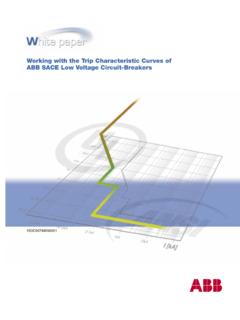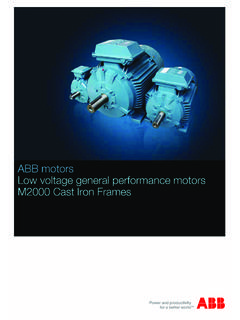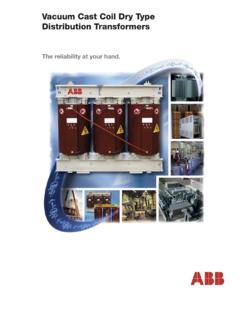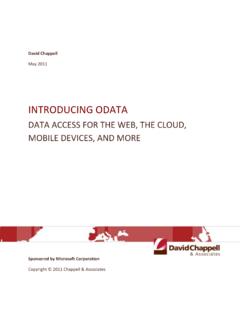Transcription of Introducing HVDC - ABB Group
1 Introducing HVDCB rochure2 ABB and hvdc The world s first commercial high-voltage direct current ( hvdc ) link, situated between the Swedish mainland and the island Gotland, was delivered by ABB already in the 1950 s. ABB has participated in the delivery of more than half of the world s around 170 hvdc is an established technology that has been in commercial use for 60 years. During the first 30 years, it was a niche technology, with a limited number of installations per year. With the changes in demands due to evolving environmental needs, hvdc has become a common tool in the design of future global transmission are two types of hvdc , the classic technology using thyristors for conversion, and VSC (voltage source converters) technology, by ABB called hvdc Light, which uses transistors (IGBT s) for conversion. A classic hvdc transmission typically has a power rating of several hundreds of megawatts (MW) and many are in the 1,000 3,000 MW range.
2 They use overhead lines, or undersea/underground cables, or a combination of cables and Light was launched in 1997 and is an adaptation of classic is used to transmit electricity in lower power ranges (from under 100 to 1,200 MW) over short and medium long distances. The technology can use overhead lines or environmentally sound oil-free underground and underwater s most recent development is ultrahigh-voltage direct current (UHVDC) with a rated voltage of up to 800 kilovolts (kV). Transmission at this voltage represents the biggest leap in transmission capacity and efficiency in more than two increase lifetimeAs a general rule, it is assumed that the major electrical equipment in hvdc stations has a lifetime of 30 to 40 years. Refurbishing an existing hvdc link can increase its lifetime or take advantage of new technology using new solutions that significantly improve operational over ten deliveries, ABB is the only supplier on the market with a vast experience of upgrading existing hvdc links.
3 31 hvdc converter station rectifier | 2 hvdc converter station inverter | 3 Alternating current (AC) | 4 Direct current (DC) hvdc transmission is an efficient technology designed to deliver large amounts of electricity over long distances with low losses. It can also interconnect incompatible AC networks and stabilize the surrounding grid. This is hvdc often emissions-free renewable sources like hydro or wind to load centers where it is needed, hundreds or even thousands of kilometers away. Once installed, hvdc transmission systems become an integral part of the electrical power system, improving the overall stability and hvdc systems core component is the power converter, which serves as the interface with the AC transmission system. The conversion from AC to direct current (DC), and vice versa, is achieved by controllable electronic switches, called valves. Benefits of HVDCHVDC systems can transmit more electrical power over longer distances than a similar alternating current (AC)transmission system, which means fewer transmission lines are needed, saving both money and land.
4 In addition to significantly lowering electrical losses over long distances, hvdc transmission is also very stable and easily controlled, and can stabilize and interconnect AC power networks that are otherwise hvdc market is growing rapidly and has become an important part of many transmission grids; not least because it can connect remote sources of electrical generation 123344 hvdc reduces electrical losses and costs, and sometimes it is the only possible solution for enabling the use of renewable energy transmission link has its own set of requirements justifying the choice of hvdc , but the most common points in favor include: Asynchronous interconnections Long distance water crossing Lower losses Controllability Environmental concerns Limit short-circuit currents Lower investment costWhy use high voltage instead of low voltage?To reduce electrical losses. When electric power is transmitted over long distances, electrical losses are lower if the current is low.
5 This is obtained by using high is an hvdc transmission link?An hvdc transmission link consists of three main components: a station to convert the alternating current of the grid to direct current, the transmission equipment itself in the form of cables and overhead lines, and another station that converts DC back into AC so that it can be used by terminal costsAC terminal costsTotal DC costsAC line costsTotal AC costsCritical distanceInvestment costDistanceDC line costsHVDC has a higher initial cost the converter stations but because the means of transmission (the overhead lines and the cables) are less expensive per kilometer with DC, there is a break-even distance. Advantages with hvdc Why DC instead of AC?To reduce electrical losses and costs and sometimes because it is the only possible solution. AC cable transmission links have a maximum distance of 50 to 100 km. For longer distances, hvdc is the only solution.
6 Furthermore, with hvdc it is also possible to connect grids that could not otherwise be connected, with different frequencies 50 Hertz and 60 is usually transmitted using three-phase AC systems. In DC systems, only two conductors are necessary to transmit electricity, and with lower losses than AC systems of similar scope. DC long distance transmissions require only a narrow power corridor as shown in the illustration AC overhead line | 2 DC overhead line | 3 DC land cables123 5 Wind power | Solar power | HydroAlternatives to burning fossil fuels for electricity, including hydro, wind and solar generation, are often located in remote locations. Hence the need for robust electrical transmission systems to ensure high availability, minimal maintenance and, of course, low transmission systems offer the best technical and economical long distance transmission solutions, integrating renewable generation, and stabilizing power networks.
7 With its inherent technical properties and superior ability of control, hvdc is a key component in the future energy system based on renewable energy an increasing number of installed hvdc links, in combination with a rising need of back-up power for the often volatile power supply from renewable energy generation, the concept of continental hvdc grids are now being discussed around the world. In order to meet the market demands, ABB has a grid simu lation center, located in Sweden, where faults in the surrounding AC grids are simulated and the advanced control system of an hvdc grid is renewable energy sources wind and solar are volatile, demanding stabilization of the network receiving its power and back-up power, preferably in the form of hydro power, which often is located remotely from the wind and solar generation. hvdc and renewable energy sources6 hvdc applications1 Connecting remote generationSome energy sources, such as hydro and solar power, are often located hundreds or thousands kilometers away from the load centers.
8 hvdc will reliably deliver electricity generated from mountain tops, deserts and seas across vast distances with low losses. Interconnecting gridsConnecting AC grids is done for stabilization purposes and to allow energy trading. During some specific circumstances, the connection has to be done using hvdc , for example when the grids have different frequencies or when the connection has to go long distances over water and AC cables cannot be used because of the high offshore windWind parks are often placed far out at sea, because the wind conditions are more advantageous there. If the distance to the grid on land exceeds a certain stretch, the only possible solution is hvdc - due to the technology s low from shoreTraditionally, oil and gas platforms use local generation to supply the electricity needed to run the drilling equipment and for the daily need of often hundreds of persons working on the platform.
9 If the power is instead supplied from shore, via an hvdc link, costs go down, emissions are lower and the working conditions on the platform are links in AC gridsHVDC links within an AC grid can be successfully utilized to strengthen the entire transmission grid, especially under demanding load conditions and during system disturbances. Transmission capacity will improve and bottlenecks be dissolved. City-center infeedHVDC systems are ideal for feeding electricity into densely populated urban centers. Because it is possible to use land cables, the transmission is invisible, thus avoiding the opposition and uncertain approval of overhead remote loadsIslands and remotely located mines often have the disadvantage of a weak surrounding AC grid. Feeding power into the grid with an hvdc link, improves the stability and even prevents is the preferred system for use in a variety of transmission applications, using submarine cables, land cables and overhead Connecting offshore wind | 2 City-center infeed | 3 Power from shore | 4 Connecting remote loads 1324 7 Energy infrastructure is an essential building block of our society.
10 With the increased integration of energy markets, the need to enhance security of supply and to integrate renewable energy sources, a European hvdc grid could evolve. hvdc grids 1321 Offshore wind | 2 Hydro | 3 SolarOver time, the point-to-point connections and the regional multi-terminal projects could be connected with each other to more extensive grids. The first small regional systems can be operated without DC breakers, but as the size and complexi-ty increase, breakers will be gradually is an hvdc grid?An hvdc electricity grid that can operate: Independently of one or several disturbances (isolate a failure) In different operation modes in the connected AC and DC systemsTechnology gaps for the full realization include: Power flow control Automatic network restoration High voltage DC/DC convertersGlobal rules and regulations for operation are required for market hvdc grids and not single hvdc links or AC?















